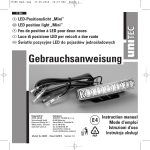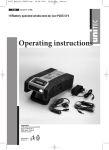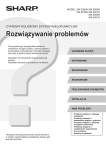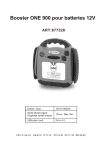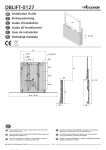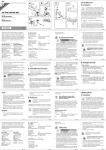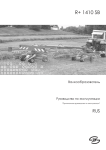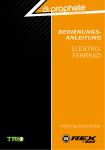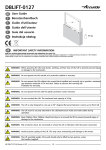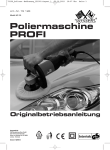Download Gebrauchsanweisung
Transcript
77084 Bed.:Lay 01.03.2011 14:26 Uhr Seite 1 77 084 D LED-Tagfahr-/ Positionslicht LED vehicle daylight / marker light F Feu de jour/feu de position LED I Luce di marcia diurna / di posizione a LED Światła LED do jazdy dziennej/pozycyjne Gebrauchsanweisung Hergestellt für: INTER-UNION Technohandel GmbH Klaus-von-Klitzing-Straße 2 76829 Landau · Germany www.inter-union.de Dystrybutor: INTERTEC POLSKA Sp. z o.o. 05-830 Nadarzyn, Stara Wieś ul. Grodziska 22 tel: 22 738-64-60, fax: 22 738-64-68, 69 www.intertec-polska.pl E-mail: [email protected] E4 Modell: JS-09308 · Stand: 02/2011 · Version: 1.1 20 PAP Instruction manual Mode d’emploi Istruzioni d’uso Instrukcja obsługi 77084 Bed.:Lay 01.03.2011 14:26 Uhr Seite 2 D Bedienungs- und Sicherheitshinweise Willkommen Sicherheitshinweis Technische Daten: Gebrauchsanweisung Achtung: Dieses LED Tagfahr-/Positionslicht von UNITEC ist sehr sorgfältig konstruiert und hergestellt worden, damit es immer zuverlässig arbeitet. Bevor Sie das LED Tag-/Positionsfahrlicht benutzen, lesen Sie bitte diese Hinweise genau durch; Sie erfahren darin alles, was Sie wissen und beachten müssen, damit das LED Tag-/Positionsfahrlicht Ihnen viele Jahre lang gute Dienste leistet. Bewahren Sie diese Hinweise für spätere Anfragen bitte auf. Bitte die zulässige Montagebreite und -höhe beachten Abb. 1 (siehe Plan). Der Abstand zwischen den beiden LED Tagfahr/Positionslichtern muss mindestens 600 mm betragen. Der maximale Abstand von 400 mm vom Ende der LED Tagfahr/Positionslichter bis zur Außenkante des Kotflügels muss eingehalten werden. Der Mindestabstand des LED Tagfahr/Positionslichts zur Fahrbahn muss mind. 250 mm betragen. Die max. Montagehöhe beträgt 1500 mm zur Fahrbahn. Beide LED Tagfahr-/Positionslichter müssen die gleichen Abstände zur Außenkante des Fahrzeugs und Boden einhalten. Bitte die Zündung und den Motor während den Arbeiten an der Elektrik ausschalten, da es ansonsten zu einem Kurzschluss oder auch zu Verletzungen kommen kann. Sollten während der Montage Unklarheiten oder Bedenken hinsichtlich der persönlichen Fähigkeiten auftreten, wenden Sie sich bitte an eine Fachwerkstatt. Abb. 2 Geeignet für 12V und 24V DC Betrieb. LED-Leistung ca. 6 Watt gelbes Kabel Vor Montage des LED Tagfahr-/Positionslichts entfernen Sie bitte die Kabel (weiß und schwarz) von den Kabeln der Batterieboxen. Diese sind verbunden wegen der sogenannten Testfunktion. schwarzes Kabel weißes Kabel Nach Montage des LED Tagfahr-/Positionslichts an entsprechender Stelle Ihres Fahrzeuges, nach den Vorgaben aus Abbildung 1, folgt nun der Anschluss an der Bordelektronik. Hierzu beachten Sie bitte den angegebenen Schaltplan (Abbildung 2). 1. Befestigen Sie beide gelben Leitungen an beiden LED Tagfahr-/Positionslichtern sowie an beiden + (plus) Kabeln des Standlichtes. 2. Verbinden Sie beide LED Tagfahr-/Positionslichter mit dem schwarzen Kabel, sowie mit einer Leitung des – (minus) Pol der Fahrzeugbatterie, oder einem geeigneten Massepunkt Ihres Fahrzeugs (Karosserie). 3. Verbinden Sie als letzten Schritt, das weiße Kabel mit den LED Tagfahr-/Positionslichtern sowie dem + (plus) Pol Ihrer Fahrzeugbatterie. 4. Setzen Sie die serienmäßigen vorderen Standlichter / Positionslichter ihres Fahrzeuges dauerhaft außer Funktion. 5. Beim erstmaligen Anschluss an die Batterie erlischt das LED-Tagfahr/Positionslicht nach einigen Sekunden. Dies ist völlig normal. Bitte beachten Sie, dass das LED-Tagfahr-/Positionslicht nur bei laufendem Motor einwandfrei funktioniert. Bei ausgeschaltetem Motor funktioniert nur das abgedimmte Positionslicht, bei entsprechender Schalterstellung im Fahrzeug (Standlichtfunktion). Gegebenenfalls kann die Installation des LED Tagfahr-/Positionslichts zu Störungen bzw. Fehlermeldungen der Bordüberwachung (Bordcomputer) führen. In diesem Fall suchen Sie bitte eine Fachwerkstatt auf. Diese kann den Fehler dann ggf. ausschalten bzw. beheben. Nach der erfolgreichen Installation, sollte das LED Tagfahr-/Positionslicht bei Einschalten des Motors funktionieren. Im Nachgang bitten wir Sie noch zu prüfen, ob die LED-Tagfahrleuchte bei Einschalten des herkömmlichen Abblendlichts, sich in den Positionslicht-Modus schaltet. D.h. die Leuchtkraft der LED´s wird etwas schwächer werden. Bei neuen Fahrzeugen u.a. Audi, VW ab Baujahr 2006 wurde die Stromstärke, welche an die Leuchten geht, etwas geschwächt, um die Lebensdauer der Leuchtmittel zu verlängern. Dies kann dazu führen, dass die LED-Leuchten nicht ordnungsgemäß auf Positionslicht umschalten (Dimmung) bei Einschalten des herkömmlichen Abblendlichts. Um die Funktion dennoch nutzen zu können, sollten Sie anhand Abb. 3 herkömmliche 12 V / 10 A-Relais installieren, welche nicht im Lieferumfang enthalten sind. Abb. 3 Plus-Kabel Parkleuchte (links) Masse Plus-Kabel Parkleuchte (rechts) Masse gelbes Kabel gelbes Kabel Leuchte Leuchte (rechts) (links) schwarzes Kabel schwarzes Kabel weißes Kabel weißes Kabel Die Kabel sind nicht im Lieferumfang enthalten Entsorgungshinweis Reinigung Entsorgen Sie dieses Produkt nach der Lebensdauer nicht im Hausmüll, sondern führen Sie dieses Produkt einer fachgerechten Entsorgung zu. Ihr Öffentlicher Entsorgungsträger hilft Ihnen gerne weiter. Verwenden Sie zur Reinigung nur Wasser, milde Seife und ein weiches Tuch. Verwenden Sie keine Lösungsmittel wie Spiritus oder Benzin. Lösungsmittel können das Material angreifen. 77084 Bed.:Lay 01.03.2011 14:26 Uhr Seite 3 GB Operating and safety instructions These LED vehicle daylight / marker lights from UNITEC have been carefully designed and manufactured to ensure all-round reliability. Before using your LED vehicle daylight / marker light, please read carefully through these instructions, which contain all you need to know in order to ensure that your LED vehicle daylight/marker lights give you many years of reliable service. Please keep the instructions in a safe place for future reference. Welcome Please observe the permitted installation-width and height limits (see plan). The two LED lamps must be fitted at least 600 mm apart from one another. Be sure to observe the maximum distance of 400 mm between the side of the LED lamp and the outer edge of the vehicle’s wing. The minimum distance between the LED lamp and the roadway is 250 mm. The maximum installation height with respect to the roadway is 1500 mm. Both lamps must be at the same distance from the roadway and their respective sides of the vehicle. Note on safety Fig. 1 In order to prevent short circuits and possible injuries, stop the engine and switch off the ignition before carrying out electrical work of any kind. If you are in any doubt as to your level of knowledge or skill, please contact a specialist installation workshop. Suitable for 12V DC and 24V DC systems. LED power capacity approx. 6 watts Technical specifications Fig. 2 LED vehicle daylight / marker lights offer the extra safety that comes with increased visibility in traffic. Function yellow wire Fitting instructions Disconnect the wires (coloured white and black respectively) from the battery-box wires before installing the LED vehicle daylight / marker lights. These are used to carry out the test function. black wire white wire Once you have installed your LED vehicle daylight/marker lights in their corresponding positions on the vehicle, following the instructions shown in fig. 1, you can connect them to the onboard electronic system. Please refer to the circuit diagram shown above (fig. 2) when doing so. 1. Connect the yellow wire to both lights and one wire to the + (plus) pole lead of the existing sidelight. 2. Connect both LED vehicle daylight / marker lights to the black wire, and also to a wire leading from the - (negative) pole of the vehicle’s battery, or to a suitable earthing (ground) point on the body. 3. To conclude the operation, connect the white lead to the lights and to the + (plus) terminal of your vehicle’s ignition system. 4. Permanently deactivate your vehicle’s standard front parking lights/marker lights. In principle the installation of the LED vehicle daylight/marker light may cause faults or error messages in the onboard monitoring system (onboard computer). In this event contact a specialist garage. It may be able to rectify or eliminate the fault. You can also read or delete this fault with an “OBD II scanner”. Once installation is complete, the LED vehicle daylight/marker light should work when the engine is switched on. Then please also check that the LED vehicle daylight light switches to the marker light mode when the normal headlights are switched on i.e. the brilliance of the LEDs will be somewhat reduced. In new vehicles, including Audi and VW from build year 2006, the current strength going to the lamps was somewhat reduced into order to prolong the service life of the lights. In consequence, it may be that the LED lights do not correctly switch to position light (dimming) when the conventional headlights are switched on. In order to continue using the function, you should install a conventional 12 V / 10 A relay as shown in fig. 3; this relay is not included in the scope of delivery. Attention: Fig. 3 positive wire of parking light (left side) ground positive wire of parking light (right side) ground yellow wire yellow wire lamp lamp (left side) (right side) black wire white wire black wire white wire The cables are not included in the scope of deliverie Do not dispose of this product in the domestic waste at the end of its useful life. You can find out more details from your official disposal body. Do not dispose of the battery in the domestic waste but take it to the special waste disposal point. Disposal instructions 77084 Bed.:Lay 01.03.2011 14:26 Uhr Seite 4 F Instructions d'utilisation et consignes de sécurité Bienvenue Instructions de sécurité Données techniques: Fonction: Instructions d’utilisation: Attention : Ces feu de jour/feu de position LED d’UNITEC ont été conçus et fabriqués avec le plus grand soin pour permettre un fonctionnement fiable à tout moment. Veuillez lire ces instructions attentivement avant d’utiliser les feux de jour/feu de position LED ; vous y apprendrez tout ce que vous avez besoin de savoir et de respecter pour que les feux de jour/feu de position LED vous rendent de bons services pendant de nombreuses années. Veuillez conserver ces instructions pour vous y référer ultérieurement. Fig. 1 Veuillez respecter la largeur et la hauteur admissibles pour le montage (voir plan). La distance entre les deux phares LED doit être d’au moins 600 mm. La distance maximale de 400 mm entre le bord du phare LED et l'extrémité hors tout de l’aile du véhicule est à respecter. La distance minimale entre le phare LED et la chaussée doit être de 250 mm. La hauteur de montage maximale est de 1500 mm par rapport à la chaussée. Les deux phares doivent avoir la même distance par rapport à l'extrémité hors tout du véhicule et par rapport au sol. Durant l’intervention sur les pièces électriques, veuillez maintenir l’allumage et le moteur éteints, pour éviter tout risque de court-circuit et de blessures. Si vous avez des doutes ou incertitudes durant le montage concernant vos facultés personnelles, veuillez vous adresser à un garage professionnel. Fig. 2 Conviennent pour un fonctionnement 12V et 24V DC. Puissance LED env. 6 watts fil jaune Les feux de jour/feu de position LED vous procurent davantage de sécurité en offrant une meilleure visibilité dans la circulation routière. Avant de monter les feux de jour/feu de position fil noir fil blanc LED, veuillez éloigner les fils (blanc et noir) des câbles de la batterie. Ceux-ci sont reliés en raison de la fonction de test. Une fois les feux de jour/feu de position LED montés sur votre véhicule, suivant les indications de la figure 1, il faut les brancher sur l’électronique embarquée. Pour ce faire, veuillez respecter le plan de câblage ci-dessous (figure 2). 1. Fixez maintenant le fil jaune aux deux feux et un fil au câble + (positif) du feu de position. 2. Raccordez les deux feux de jour/feu de position LED au câble noir et à un câble du pôle (négatif) de la batterie du véhicule, ou bien à un point de masse approprié de votre véhicule (carrosserie). 3. En dernier, raccordez le câble blanc avec les feux et avec le + (positif) après contact de votre véhicule. Si vous ne savez pas où trouver le positif après contact dans votre véhicule, veuillez vous adresser à un garage professionnel. 4. Mettez les feux de position avant montés de série sur votre véhicule définitivement hors service. En principe, l’installation du feu de jour/feu de position LED peut engendrer des perturbations ou des messages d’erreur au niveau de la surveillance embarquée (ordinateur de bord). Dans ce cas, veuillez vous adressez à un atelier spécialisé. Ce dernier est en mesure d'effacer l’erreur ou de la résoudre. Au besoin, vous pouvez également lire et effacer cette erreur au moyen d’un scanner OBD II. Après une installation réussie, le feu de jour/feu de position LED doit fonctionner lorsque vous mettez le moteur en marche. A posteriori, veuillez également vérifier si le feu de jour LED passe en mode feu de position lorsque vous allumez les feux de croisement conventionnels, c'est-àdire si l'intensité lumineuse des LED s'affaiblit quelque peu. Sur les nouveaux véhicules à partir de l’année de construction 2006, et notamment Audi et VW, l’intensité de courant destinée aux phares a été quelque peu diminuée afin de prolonger la durée de vie des ampoules. Il est possible que les lampes LED de ce fait ne passent pas correctement en feux de position (variation) lorsqu’on allume les feux de croisement. Afin de pouvoir cependant utiliser la fonction, il vous est recommandé d’installer comme l’indique les figures ci-contre un relais traditionnel 12 V/10 A qui n’est pas compris dans les fournitures (Fig. 3). Fig. 3 Câble positif du feu de position (côté gauche) Terre Câble positif du feu de position (côté droit) Terre Fil jaune Fil jaune Phare Phare (côté gauche) (côté droit) Fil noir Fil noir Fil blanc Fil blanc Les câbles ne sont pas compris dans les fournitures Instructions pour l’élimination À la fin de la durée de vie de ce produit, ne l‘éliminez pas avec les ordures ménagères. Pour en savoir plus, merci de vous adresser à l’organisme de droit public compétent. N’éliminez pas l'accumulateur avec les ordures ménagères mais faites-le parvenir à un point de collecte de déchets toxiques. 77084 Bed.:Lay 01.03.2011 14:26 Uhr Seite 5 I Istruzioni per l’uso e avvertenze sulla sicurezza I presenti luce di marcia diurna / di posizione a LED di UNITEC sono stati progettati e prodotti con la massima accuratezza, affinché funzionino sempre con la dovuta affidabilità. Prima di utilizzarli, si raccomanda di leggere attentamente ed osservare le istruzioni a seguito riportate, per restare soddisfatti lunghi anni del vostro acquisto. Conservare le presenti istruzioni per una successiva consultazione. Fig. 1 Rispettare la larghezza ed altezza di montaggio ammessa (v. schizzo). La distanza tra i due fari a LED deve ammontare ad almeno 600 mm. Osservare assolutamente anche la distanza massima di 400 mm dall’estremità del faro a LED allo spigolo esterno del parafango. La distanza minima tra il faro a LED e la corsia deve ammontare a 250 mm. L’altezza di montaggio massima rispetto alla corsia ammonta a 1500 mm. Entrambi i fari devono presentare le stesse distanze rispetto allo spigolo esterno del parafango e al suolo. Si raccomanda di spegnere l’accensione ed il motore durante i lavori sull’impianto elettrico, perché altrimenti potrebbe insorgere un corto circuito o anche pericolo di lesioni. Se durante il montaggio dovessero manifestarsi incertezze o dubbi a riguardo delle proprie capacità, è consigliabile rivolgersi ad un’officina specializzata. Fig. 2 Indicato per il funzionamento a corrente continua DC 12V e 24V . Potenza LED ca. 6 Watt cavo giallo Il luce di marcia diurna / di posizione a LED vi offrono maggior sicurezza grazie ad una migliore visibilità nella circolazione stradale. Prima di montare i luce di marcia diurna / di posicavo nero cavo bianco zione a LED, rimuovere i cavi (bianco e nero) dai cavi delle cassette portabatteria. Questi sono collegati per via della cosiddetta funzione di prova. Dopo aver sistemato in base alla Fig. 1 i luce di marcia diurna / di posizione a LED sui relativi punti della vettura, si effettua l’allacciamento all’impianto elettronico di bordo. A tal fine osservare lo schema dei collegamenti sottostante (Fig. 2). 1. Fissare ora il conduttore giallo su entrambi i fari, nonché un conduttore sul cavo + (positivo) del fanale di posizione. 2. Collegare entrambi i luce di marcia diurna / di posizione a LED al cavo nero, nonché ad un conduttore del polo - (negativo) della batteria auto, o ad un punto massa idoneo della vostra vettura (carrozzeria). 3. Per ultimo collegare il cavo bianco ai fari nonché al polo + (positivo) del blocchetto d’accensione auto. Se non sapete come trovare il polo positivo del blocchetto d’accensione, è consigliabile rivolgervi ad un’officina specializzata. 4. Mettere permanentemente fuori servizio le luci di posizione anteriori di serie del proprio veicolo. L'installazione della luce di marcia diurna / di posizione a LED può disturbare il sistema di monitoraggio di bordo (computer di bordo) o causare messaggi di errore. In questo caso rivolgersi a un'officina specializzata che potrà eliminare il disturbo. Eventualmente è possibile selezionare e cancellare l'errore anche tramite un cosiddetto scanner OBD II. Se l'installazione è stata eseguita correttamente, all'accensione del motore la luce di marcia diurna / di posizione a LED dovrebbe funzionare. Verificare poi se, all'accensione degli anabbaglianti tradizionali, la luce di marcia diurna a LED si commuta nella modalità luce di posizione, ovvero se la luminosità dei LED diminuisce. A partire dall'anno di costruzione 2006 nei nuovi veicoli, tra cui Audi e VW, l'intensità della corrente diretta alle luci è stata leggermente diminuita per allungare la vita utile delle sorgenti luminose. Di conseguenza, all'accensione degli anabbaglianti tradizionali, le luci a LED potrebbero non commutarsi regolarmente in luci di posizione (variazione dell'intensità luminosa). Per utilizzare comunque la funzione è possibile installare un relè tradizionale da 12 V / 10 A, non compreso nella fornitura, seguendo le illustrazioni riportate accanto (Fig. 3). Benvenuti Norme di sicurezza Dati tecnici: Finalità: Istruzioni d’uso: Attenzione: Fig. 3 Cavo positivo della luce di posizione (lato sinistro) Terra Cavo positivo della luce di posizione (lato destro) Terra Cavo giallo Cavo giallo Faro Faro (lato sinistro) (lato destro) Cavo nero Cavo bianco Cavo nero Cavo bianco I cavi non sono compresi nella fornitura Al termine della sua vita non smaltire questo prodotto tra i rifiuti domestici. Per maggiori informazioni rivolgersi al proprio gestore pubblico di rifiuti. Non smaltire la batteria tra i rifiuti domestici, bensì tra i rifiuti speciali. Istruzioni per lo smaltimento 77084 Bed.:Lay 01.03.2011 14:26 Uhr Seite 6 PL Instrukcja obsługi oraz wskazówki Witamy Wskazówka bezpieczeństwa Dane techniczne: Funkcja: Instrukcja obsługi: Uwaga: Światła LED do jazdy dziennej/pozycyjne firmy UNITEC zostały skonstruowane i wyprodukowane z zachowaniem najwyższej staranności, tak by zapewnić ich niezawodne działanie. Przed użyciem świateł LED do jazdy dziennej/pozycyjne należy uważnie przeczytać następujące wskazówki. Dowiedzą się Państwo z nich wszystkiego, co należy wiedzieć i czego przestrzegać, aby światła LED do jazdy dziennej/pozycyjne niezawodnie służyły przez wiele lat. Należy zachować te wskazówki na wypadek późniejszych zapytań. Należy przestrzegać dopuszczalnej szerokości i Ilu. 1 wysokości montażu (patrz układ). Odstęp pomiędzy dwoma reflektorami LED powinien wynosić przynajmniej 600 mm. Należy zachować maksymalny odstęp – 400 mm między końcem reflektora LED a zewnętrzną krawędzią błotnika. Minimalny odstęp pomiędzy reflektorem LED a jezdnią powinien wynosić 250 mm. Maksymalna wysokość montażu wynosi 1500 mm ponad jezdnią. Odstępy między reflektorami i zewnętrzną krawędzią pojazdu oraz podłożem powinny w przypadku obu reflektorów być jednakowe. Należy wyłączyć zapłon i silnik podczas prac przy instalacji elektrycznej, ponieważ może dojść do zwarcia a także obrażeń ciała. Jeśli w trakcie montażu pojawią się niejasności lub wątpliwości dotyczące własnych umiejętności, należy zwrócić się do specjalistycznego warsztatu. Ilu. 2 Przeznaczone do napięcia 12 V i 24 V zasilanie kable żółty DC , moc LED ok. 6 W Światła LED do jazdy dziennej/pozycyjne zapewniają Państwu większe bezpieczeństwo dzięki lepszej widoczności w ruchu drogowym. kable czarnego kable białego Przed montażem lamp do jazdy dziennej z diodami LED należy rozdzielić kable (koloru białego i czarnego) od kabli skrzynki akumulatora. Są one ze sobą połączone z powodu tzw. funkcji testowej. Po montażu lampy LED do jazdy dziennej/pozycyjne w odpowiednim miejscu pojazdu według wytycznych zamieszczonych na ilustracji nr 1 następuje podłączenie do instalacji elektronicznej pojazdu. Należy uwzględnić przy tym podany układ połączeń (ilustracja nr 2). 1. Żółty przewód przymocować do obu lamp oraz jeden przewód do kabla o biegunie + (dodatnim) świateł postojowych. 2. Połączyć obie lampy LED do jazdy dziennej/pozycyjne za pomocą czarnego kabla oraz przewodu o biegunie – (ujemnym) akumulatora pojazdu lub z odpowiednim punktem masy w pojeździe (karoseria). 3. Na koniec podłączyć biały kabel do lamp oraz do + (plusa) załączanego plusa pojazdu. Jeśli nie wiedzą Państwo, gdzie w pojeździe znajduje się załączany plus, należy zwrócić się do specjalistycznego warsztatu. 4. Wyłączyć na stałe seryjne przednie światła postojowe/światła pozycyjne pojazdu. Zasadniczo instalacja świateł LED do jazdy dziennej/postojowych może prowadzić do zakłóceń lub komunikatów o błędzie w komputerze pokładowym. W takim wypadku należy zgłosić się do specjalistycznego warsztatu, gdzie komunikat i błąd zostaną usunięte. Błąd można wyszukać i usunąć także z użyciem skanera diagnostycznego OBD II. Po udanej instalacji światła LED do jazdy dziennej/pozycyjne powinny zacząć działać w momencie uruchomienia silnika. Dodatkowo należy jeszcze sprawdzić, czy światła LED do jazdy dziennej w momencie włączenia zwykłych świateł mijania przechodzą w tryb świateł pozycyjnych, tzn. czy zmniejsza się siła światła LED. W nowych pojazdach między innymi marek Audi i VW począwszy od rocznika 2006, aby wydłużyć żywotność opraw oświetleniowych, zmniejszono nieco moc zasilającego je prądu. Może to doprowadzić do tego, że przy włączaniu tradycyjnych świateł mijania, oprawy LED mogą nie przełączać się poprawnie na tryb świateł pozycyjnych (ściemnianie). Aby mimo to umożliwić działanie tej funkcji, należy zainstalować, stosując się do umieszczonych obok rysunków, tradycyjne przekaźniki 12 V / 10 A ((ilustracja nr 3). Przekaźniki te nie wchodzą w zakres dostawy. Ilu. 3 Biegun dodatni przewodu światła postojowego (Strona lewa) Masa Biegun dodatni przewodu światła postojowego (Strona prawa) Masa Kable żółty Kable żółty Lampa Lampa (strona lewa) (strona prawa) Kable czarnego Kable białego kable czarnego Kable białego Kable nie wchodzą w zakres dostawy Recykling W momencie, kiedy urządzenie stanie się bezużyteczne, nie wolno wyrzucać go do pojemników z domowymi śmieciami, tylko poddać recyklingowi zgodnie z obowiązującymi krajowymi przepisami w tym względzie. Akumulatory muszą zostać poddane recyklingowi w miejscach do tego przenaczonych.







